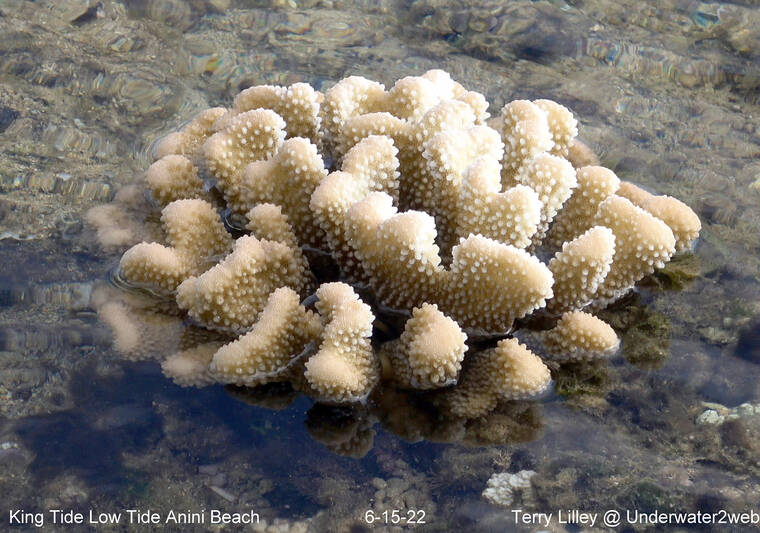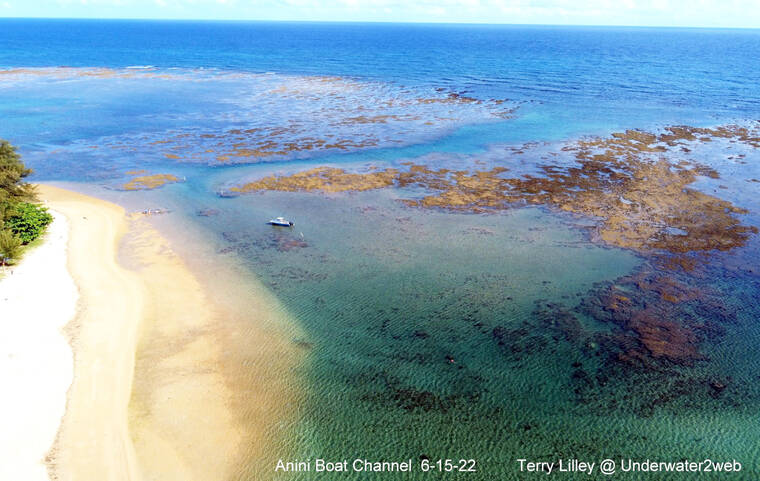‘ANINI — King tides.
It sounds majestic. And in many ways, it is, described as “the highest high tides of the year.”
King tides tend to happen during the summer and winter months when the moon is at its closest point to the Earth during its monthly orbit. It also takes place when the sun, the moon and the Earth are in alignment, meaning that the sun and moon’s individual gravitational pulls work together to produce the highest high tides of the year.
And on Tuesday and Wednesday, people were asked to use their smartphones to submit photos to document the king tides for the University of Hawaiʻi Sea Grant College Program’s Hawaiʻi and Pacific Islands King Tides Project.
The goal was “to better understand tomorrow’s impacts from sea-level rise and other coastal hazards. King tides provide a window into our future because today’s high tides are tomorrow’s average sea levels.”
But Hanalei Marine Biologist Terry Lilley said Wednesday that king tides were having a negative effect at ‘Anini Beach Park.
“Most people monitor the king tides by how high the tide comes up, but with a super high tide there will also be a super low tide,” he wrote in an email to TGI. “Anini Beach right now is dry reef all the way to the outer edge 100 yards off shore.”
Lilley wrote that hundreds of thousands of corals were bone dry and baking in the hot sun.
“This kills the algae within the coral and causes bleaching,” he wrote. “Corals did not evolve to be in the open air and sunshine, so many of them will die from this extreme tidal event.”
What was also bad was that people were walking on dry reef, stepping on the corals while they try to catch fish and octopus stranded in the tide pools.
“At ‘Anini Beach the tide is so low the boats can’t get in and out of the channel,” Lilley said.
The king tides do not affect the coastline due to flooding for very long, and within a day everything on land dries out, Lilley said, “but out on the reef it is a way-larger problem. When millions of corals are exposed to the direct UV light from the sun along the coast of Kaua‘i there could be a massive coral die-off.”
Lilley said he has over 16,000 images of the coral growing at ‘Anini Beach over the past five years.
“It will be interesting to see how many die from this king tide event,” he wrote.
According to the UH Sea Grant College, Hawaiʻi kingtides “can have devastating consequences for coastal inhabitants, particularly when combined with severe weather or high-wave events. It is a common misconception that king tides are the result of man-made climate change when in reality they are not byproducts of climate change, rather they are windows for us to see what the future of sea-level rise from global climate change might look like along our coastlines.”




Anyone measure that sea level rise lately? Seriously the reefs will come back like they always do.
Have some perspective. This is not the first king tide to affect the islands, nor the last. Zooxanthellae do leave the coral but they can also return.